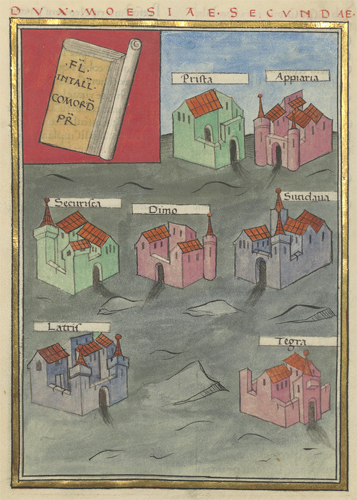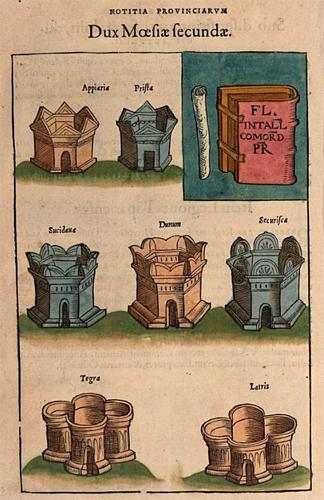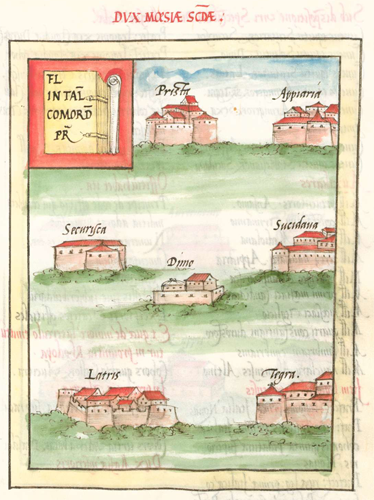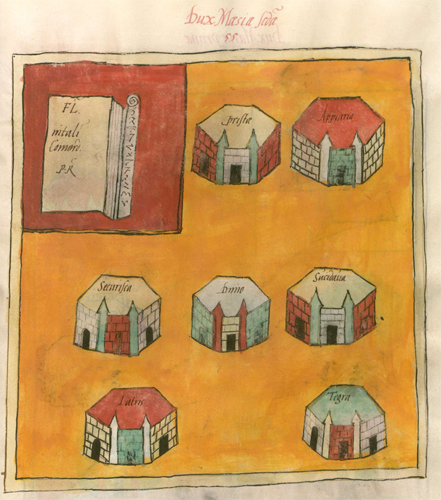
This page created 1 January 2003, and last modified: 7 February 2015 (bottom four frontpiece illustrations added)

 Above: Frontpiece from the Bodleian manuscript (O). The stations depicted are: Prista, Appiaria, Securisca, Dimo, Sucidava, Latris, Tegra. |
The following cavalry units (or detachments of units) are listed as being under the command of the Duke of second Moesia (i.e. northeast Bulgaria; the numbers beside the names refer to Ingo Maier's numbering scheme):
76.2 Cuneus equitum scutariorum, at Securisca along with the following auxiliary infantry units (or detachments of units):
76.10 Milites praeventores, at Ansamo and the following (prefects and their) legionary units stationed long the riverine frontier (i.e. of the Danube):
76.21 Praefectus legionis primae Italicae, at Novasalong with the following units "from a lesser register": In the province of Rhodopa:76.36 Cohors quarta Gallorum, at UlucitraIn the province of Thracia:76.38 Cohors prima Aureliana, under Radice-Viamata |
The men under the various praefecti legionis XI Claudiae are detachments of Legio XI Claudia, long stationed at Durostorum (modern Silistra in northeast Bulgaria). Other detachments of this legion would appear to be the Undecimani under the Comes "Hispenias" and the Undecimani under the Magister Militum Praesentalis II.
The men under the praefecti legionis primae Italicae are likewise detachments of Legio I Italica, is is undoutably the Primani under the Magister Militum Praesentalis II. Legio I Italica was continuously stationed in Moesia since 70 AD, although detachments are of course recorded elsewhere at times; for example, an inscription (AE 1984,808) from Kherson in the southern Ukraine gives LE[...] ITAL ET [...]RCVLIA, which expands to "legiones I Italica et II Herculia"; while another (AE 1994,1539) from the same place gives VIXI[...]ONIS LE[...] ITAL ET [...]RCVLIA, which expands to "v[e]xillationis legionis I Italicae et legionis II Herculiae".
The Cuneus equitum Solensium might perhaps be the cavalry component of the old Legio XX Valeria Victrix, renamed the Solenses (see the discussion under the Dux Britanniarum); infantry components of the Solenses are found under the Magister Militum per Thracias.
In the Notitia, in some Danubian commands, the legions are split between up-river ("superioris") and down-river ("inferioris") sections; see Peter Kovacs, The late Roman army in Pannonia (2004), available here. This is the case of Moesia II, where we see a prefect in charge of each half of each of the two legions in the province, plus another prefect for each legion (presumably in charge of the headquarters); however, the two halves are not necessarily up- or down-river of each other as recorded in the Notitia: both halves of Legio XI are stationed at the same place, for example.
It is possible the Cimbriani, one of the western legiones palatinae, and assigned to the Comes Africae, owes its name to the fort at Cimbriana, as obviously do the auxiliary Milites Cimbriani.
Below are shown the frontpieces from the Parisian manuscript, P; and the Froben printed edition, B:


And below are shown the frontpieces from the first set of pictures in the Munich manuscript, M; and the second set, W.


Note that Sucidava is not the same locality as Sacidava listed under the Dux Scythiae; Sucidava is modern Corabia in Romania, on the left (northern) bank of the Danube, while Sacidava lies ca. 300 km to the east (modern Rasova), and is on the right (southern) bank.

Return to the Notitia index page.